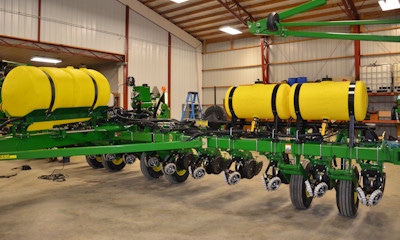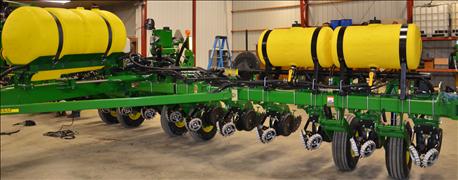
Is your planter ready to roll? Are you sure? You might want to take a second look at three key components before planting day arrives.
A couple years ago Clint Arnholt, Columbus, brought home a new John Deere planter and then customized it to fit his needs in his own shop. He looked at several key areas.
Since he does primarily no-till, often into cover crop or cover crop residue, none were more important that making sure he could clear away residue for seed placement, choosing the right metering system to drop the seed and equipping the planter to close the slot after the seed was placed.
Here’s a closer look at these three key areas:
1. How will you prepare the row area?

SET IT UP AS YOU WANT: There is still time to make adjustments in how your planter is equipped before you ‘re ready to plant.
Both major manufacturers and short-line companies offer an abundance of choices for residue wheels. Arnholt selected these tredder-style wheels when he put his planter together. Most say the important part is to know how much residue you want to remove, and what kind of seedbed you want the seed openers which follow the residue wheels working in. If you don’t have residue wheels and want to add them, you can choose from systems that require manual adjustment, or systems that lift and position residue wheels, either hydraulically or electrically.

CHOOSE ROW CLEANERS: This planter is equipped with just one of many options for row cleaners.
2. Choose your metering system
Electric control of row units is picking up steam. If you haven’t looked closely at upgrading to electric meters yet, you may want to do so. Several companies offer various options that allow you to upgrade row units so that you can control them electrically, eliminating a lot of moving parts including the drive chain; and providing you with much more precise control of every planter row.

PICK DRIVE FOR METERING SYSTEM: You can choose from mechanical, hydraulic and electric drive (shown) for row units today.
3. How will you close the slot?
There are tons of options here, and more every year. Beck’s tests various types of closing wheel under tacky conditions in no-till. Two years ago they used a six-row planter with a different set of closing wheels on each one. Last year they went to an eight-row planter with eight types of closing wheel setups. Theree are still more choices that they haven’t tried yet. See their website and Practical Farm Research for more details about which closing wheel performed best in their tests. Hint- the same wheel doesn’t win every year.

MAKE YOUR CHOICE: Clint Arnholt chose this pair of wheels when he set up his planter. Some people use two different wheels on each row. Often they’re trying to cover all bases, in case soils are wetter or direr than they like at planting.
About the Author(s)
You May Also Like




